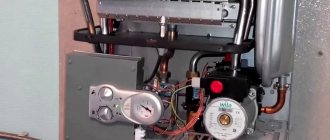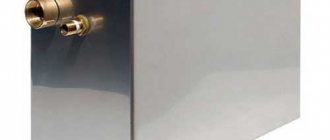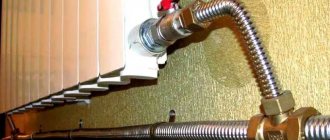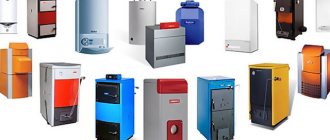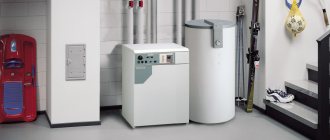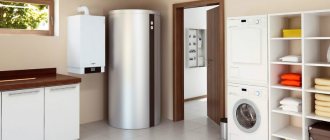As an advertisement
Double-circuit boiler equipment, solar systems and heat pumps appeared, and plastic pipes, taps and connections began to be used as materials. Installation of the system has become simpler, more convenient and more accessible for “non-professionals”; it is easier to configure and repair. The usual solution has been the use of “warm floors” based on circulation pipelines.
All these innovations led to the development of another technical solution: the use of non-freezing liquids - coolants in individual heating systems of private houses.
The use of coolants raises many questions, speculations and disputes. Some stereotypes have already formed a practice of application, which sometimes looks comical. Therefore, in this article, specialists from the OBNINSKORGSINTEZ company, Heat Transfer Fluids department, will answer the most common questions.
To use or not to use antifreeze liquid as a coolant?
There is no GOST or standard that requires the mandatory use of a coolant or prohibits its use. Sometimes there are designs for industrial systems that require the use of “water-glycol solutions,” and if you turn to heating equipment manufacturers, they also do not have a single general solution - some prohibit them altogether, others allow the use of certain brands of coolants. Which decision is correct?
The answer to this question can be obtained by taking into account a combination of many factors: this is the equipment model, the type of structure, the mode of its use, the material and insulation of the walls, the type of system, and the region of location. But the most important factor is the degree of security of the system in unforeseen, emergency cases.
eddiki
I made my own heating system for the first time in my life using metal-plastic, there are no leaks in the fittings. The argument in favor of antifreeze was given by the specialist who started my boiler - antifreeze has its drawbacks, but the main thing is to preserve the system in any force majeure. According to him, last winter a lot of COs died on the water for various reasons. I have propylene glycol, -20, the system works, and I sleep peacefully when I’m not at the dacha.
It's no secret that the main task of the coolant is to protect the system from defrosting and damage in case of unforeseen situations. And there are quite a lot of situations when a house can be left without heating for a long time:
- long-term departure of the whole family, when there is no one to heat the house;
- seasonal use of a summer house or house;
- Finally, no one is immune from gas pipeline accidents or long-term power outages, which have become common in winter after freezing rains that cut power lines.
In such conditions, the use of non-freezing liquid is an absolutely justified solution.
Which one to choose, how do they differ?
Serg3515
A lot has been written and rewritten on this topic, but I have never seen a clear answer (and preferably from a user with experience). In this regard, if I may ask some questions. So, after all, what to fill in? (what kind of non-freezing liquid). Electric boiler, two-pipe system, metal-plastic pipes.
For an uninitiated person, understanding the abundance of offers and the price range can be very difficult.
The key factor in choosing a coolant is its basis, i.e. basic chemical raw materials. The following are traditionally used as a basis:
- ethylene glycol is a toxic dihydric alcohol;
- propylene glycol is a non-toxic substance acceptable for use in the food industry.
The second selection criterion is the additives used in the coolant. There are organic additives (carboxylate) and inorganic. Additives affect the service life and quality of the coolant. Coolant with organic additives has a longer service life and, during operation, more reliably protects the system from corrosion.
The third indicator is how heating equipment manufacturers treat this product; in other words, whether a particular coolant is acceptable for use in a system where this type of equipment is used.
Rating of coolants based on a combination of quality characteristics:
- Coolant based on propylene glycol with organic additives and approvals from equipment manufacturers. This coolant provides the widest range of indicators: environmental friendliness and safety, service life, physical and chemical properties, and versatility of use, from kindergarten to food production.
- Coolant based on ethylene glycol with organic additives and approvals from equipment manufacturers. Such a coolant already has limitations in its use. You can determine its purpose: industrial facilities and systems that are reliably isolated from human activity.
- Coolant based on propylene glycol with conventional inorganic additives. Although such a product has a shorter service life, it is harmless enough to be around people and animals.
- Coolant based on ethylene glycol with inorganic additives. Poisonous, short service life. Its use is often driven by the need to save money. If the system is well isolated from contact with human life, such a solution is quite logical.
PS Coolant based on glycerin. Glycerin is the simplest trihydric alcohol, which is a viscous transparent liquid, also used as a food additive. The product has high density, kinematic and dynamic viscosity. Equipment manufacturers provide indicators several times lower than those present in glycerin-based coolant. The product has no operational or physical advantages, although it is quite easy to produce, which is why it is inexpensive. European manufacturers of chemical compounds have a very negative attitude towards the use of glycerin as a base for antifreeze liquids.
Choice for polypropylene pipes
Polypropylene pipes are in great demand due to a huge number of advantages, such as long-term operation, low price, resistance to corrosion, high hardness and low density. They come in two types: some contain aluminum, and others contain fiberglass. In addition, polypropylene pipes provide:
- maintaining high temperature conditions;
- long service life;
- absence of noise during coolant circulation.
What coolant is best for polypropylene pipes? Many options are suitable, which is why it is worth carefully studying the recommendations for use.
Should I dilute with water or not?
The origin of this issue is due to the fact that equipment manufacturers set the same requirements, worrying about the safest and most efficient operation possible. Buyers stick to their line, driven by the need to save money. And coolant manufacturers maneuver between the requirements of manufacturers, buyers and sales practices. As always, the truth is somewhere in the middle.
Manufacturers of antifreeze liquids mainly offer “-65C” or “-30C” coolants to the market. Firstly, this is due to established demand, and secondly, such a coolant is guaranteed not to be frozen at the time of sale.
Equipment manufacturers have their own truth. Thus, the density of non-freezing liquid marked “-25C”, mainly recommended by equipment manufacturers for reasons of optimal fluidity, is 1.03 g/cm3, and that of liquid “-30C” is 1.04 g/cm3.
The fact that the content of the main substance in the coolant will be several percent higher is not an “exorbitant” deviation, but taking into account the fact that water can be “added” to the coolant either when recharging the circuit, or if water is not completely drained from the system after flushing , a “reserve” of concentration is simply necessary.
On the other hand, diluting the coolant from “-30C” to “-25C” - and this value is 3-4% - will not bring tangible savings to the buyer, but will increase the risk of losing other necessary properties. But in the case when the buyer plans to use concentrated coolant “-65C” and dilute it, the savings can already be up to 20%.
What is the service life, how do you know: when to replace?
The question is quite common.
Andreic
Experts, clarify the situation: today contractors said that antifreeze has a validity period of 5-7 years. Then it loses its properties, begins to precipitate, and generally does not flow through the heating system as it should. True or not?
For coolants that contain organic (carboxylate) additives, the service life is 10 seasons (10 years), for coolants with “ordinary” silicate additives, this period is about 5 years (heating seasons). In order to control quality, every year, after the end of the heating season, you can carry out a simple procedure - pour a small amount of coolant into a transparent glass container. The resulting sample is visually inspected for the presence of mechanical and other impurities, color, and transparency. If the coolant contains mechanical impurities (crumbs, grains of scale), it can be drained, filtered, flushed the system and refilled. If there are traces of chemical changes (flakes, clots), you need to contact a specialist.
Features of dilution of ethylene glycol
To dilute concentrated ethylene glycol, demineralized softened water with a minimum content of magnesium and calcium salts is used. If anti-corrosion additives are added during the dilution process, the water hardness should not exceed 5 mg per equivalent. For convenience, you can use the following table:
| Freezing point of the working composition | Volume of ethylene glycol, in liters | Volume of water, in liters |
| -20 °C | 54 | 60 |
| -25 °C | 60 | 40 |
| -30 °C | 65 | 35 |
| -40 °C | 77 | 23 |
Important! It is not recommended to use pure ethylene glycol. It has increased viscosity and low heat capacity, which negatively affects the efficiency of the equipment.
In what systems can antifreeze liquid be used?
There are a number of restrictions on the use of antifreeze:
- Antifreeze liquid, regardless of its chemical composition, can only be used in a closed circuit. This means that there is constant pressure in the system, circulation is constantly forced, due to the pump.
- Coolants are not used with electrolysis-type electric boilers. Electrolysis type is when the coolant is used as an electrical conductor. The electrical conductivity of coolants is low, and this will lead to high energy costs.
- Antifreeze liquids must not be used in contact with galvanized surfaces (pipes).
How to decide on the required temperature, or is -30C too much or too little?
Application practice shows that the temperature in a room that has not been heated for a long time and the ambient temperature are always different. The room will always be warmer - by 10 degrees or more. Even if it’s minus 40 outside the window, and the room is frozen to minus 30, the coolant will not turn into ice and, accordingly, will not burst pipes and radiators. In order for antifreeze labeled -30C to freeze and damage the heating system, the temperature (in the house) must be below -50C, which in reality is quite difficult to imagine.
Rash98
For three seasons I have been using propylene glycol as antifreeze in a natural circulation system. Everything works perfectly. The batteries heat up after just 10 minutes. I use propylene glycol not concentrated, but diluted to the freezing point of minus 30 degrees. S. Flooded once three years ago.
On the other hand, non-freezing liquids with temperatures of minus 10, 15 and even 20C should not be used for a number of reasons:
- Even in the central regions of Russia in winter the temperature drops below these values. In such conditions, it is unlikely that anyone will want to buy a product that has turned into “snow porridge”, despite the fact that after thawing it will completely return to its properties.
- At the slightest dilution (which is very likely, especially in double-circuit boilers, or after flushing the system), the coolant without a small temperature margin will lose its necessary properties.
Is it possible to do it yourself
Antifreeze is a solution in which water makes up up to 70% of the total volume, the rest are additives that reduce the crystallization threshold to a minimum. These include the main component (glycerin, ethylene glycol and others) and additives that prevent the formation of foam and crystalline sediment as the temperature increases.
And if you can choose the main component yourself, then choosing the right additive is difficult, since their full composition has not been fully studied and the manufacturers do not disclose it. For this reason, making the composition at home correctly will not work.
If you ignore this recommendation and make an anti-freeze solution for heating your home yourself, the following consequences are possible:
- when the coolant heats up, the level of foam increases, which leads to the rapid formation of sediment on the walls of radiators and pipes;
- due to the decrease in heat transfer of a homemade anti-freeze, the heating efficiency will decrease significantly;
- homemade heating fluid can be bad for steel due to the large amount of oxygen, and corrosion will accelerate.
To prevent this from happening, using low-quality or homemade antifreeze is strictly prohibited. The liquid should be selected only from a factory-produced and reliable manufacturer.
Before pouring antifreeze into the heating system, you need to carefully re-read the instructions for it; the use of this heating element may be prohibited. The liquid itself must be selected correctly and all requirements for use must be observed.
When there was water in the system, everything was fine, they filled in the coolant and all the connections started leaking.
Arnau
It's time to decide what to fill the heating system in a country house with: distilled water or antifreeze.
The main argument against antifreeze is that it corrodes connections, leaks are possible and components need to be changed frequently.
Indeed, non-freezing liquids are more fluid than water. And fluidity increases with increasing temperature. They do not contain chemical compounds that, by forming calcium deposits, can clog microgaps. Even if the microgaps become clogged with something, coolant additives will “clean” the clogged formations and restore the leak. Therefore, more attention must be paid to the assembly of joints in a system where it is planned to use antifreeze. And, as mentioned earlier, before starting it is necessary to carry out commissioning work, including pressure testing of the system.
Calculation of the required volume of antifreeze
Let's assume that you are ready to purchase antifreeze. And here the question arises: how to fill the antifreeze if you don’t know how much of this liquid you need? Even if you are not good at mathematics, you will have to do some simple calculations. This procedure will require you to be careful and time-consuming.
First you need to measure the length of all connections to the batteries and lines. Then distribute them by diameter. For each diameter, you should measure the area of the flow section; for this you will have to remember the formula for the area of a circle (πr2). Remember that the radius is half the diameter. Next step: multiply the result by the length of the pipe.
That's not all: now take the technical data sheets of the radiators and boiler and look at the volume of water indicated in them. The first figure obtained by your calculations must be added to the figures from the technical data sheets.
When you order antifreeze, keep in mind that it will need to be diluted with water (usually 1:1). The manufacturer indicates the exact information in the instructions for the antifreeze.

